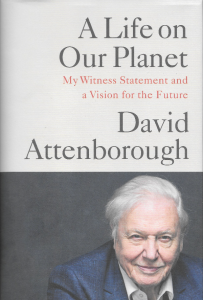The one sentence summary
A revolution in sustainability, a drive to rewild the world and stabilise our population would restore our harmony with the natural world.
Can’t be bothered to read it? Too much screen time lately? Listen to the 5-minute podcast.
WHAT THE BOOK SAYS 
- We share earth with the living world – the most remarkable life-support system imaginable, constructed over billions of years. The planet’s stability has wavered as its biodiversity has declined because the two things are bound together. The only way out of this crisis is to rewild the world.
- We often talk of saving the planet, but the truth is we must make sustainable changes to save ourselves. With or without us, the wild will return.
- During the author’s lifetime, the remaining wilderness in the world has declined from 65% to 35%, and the population has risen from 2.3bn to 7.8 bn. That’s a quadrupling in less than 100 years. As of 2020:
- We extract over 80m tonnes of seafood from oceans every year and have reduced 30% of fish stocks to critical levels.
- We have lost half of the world’s shallow water corals.
- There are currently 1.8 trillion plastic fragments in the ocean. Over 90% of seabirds have plastic in their stomachs.
- We have reduced the size of animal populations by 80%.
- We cut down 15bn trees a year. The top driver of deforestation is beef production. The second is growing soy, 70% of which is just to feed livestock. The third is oil palm plantations. Half of the fertile land on earth is now farmed.
- 70% of the mass of birds on the planet are domesticated – mainly chickens. We eat 50bn of them a year.
- 96% of the mass of all animals on earth is of those we raise to eat.
WHAT’S GOOD ABOUT IT
- The earth is a finite, closed system. The Great Acceleration will lead to a Great Decline. Microbiologists have a graph of growth that shows what happens when a few bacteria are placed on a bed of food in a sterile, sealed dish. First there is a lag phase whilst they get used to the new environment, then they start dividing. The log phase is one of exponential growth. The food runs out, the waste overwhelms the bacteria and they all die out. It’s not sustainable.
- The Planetary Boundaries model shows how we are exceeding our threshold of stability on crucial criteria such as fertilizer use, land conversion and biodiversity loss. The Doughnut Model underpins this ecological ceiling with a social foundation – basic standards for all humans covering energy, water, food, education, income, justice and much more.
- Pursuing growth for the sake of it (Gross Domestic Product) is no longer appropriate. We need to go for green growth – that which has no negative impact on the environment. There are scores of examples of how. One example is Silvopasture, which allows the raising of animals year-round in growing woodlands.
WHAT YOU HAVE TO WATCH
- This is a fascinating book that everyone should read.
